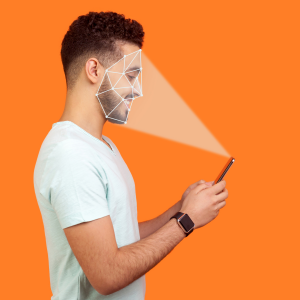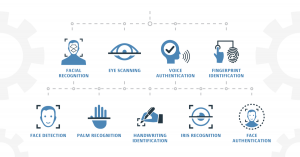Estimated reading time: 3 minutes
When it comes to securing devices and accounts, no longer are the days of relying on unique passwords to keep people safe from hackers and other cybercriminals. Many organizations now require that you adopt several forms of authentication to access your account. These additional forms could look like entering a specific code that was sent to you via text message, or perhaps even inputting a  face or fingerprint scan ID to verify that it is really you trying to log on. Mobile Biometric Authentication is a form of authentication that uses biometrics to detect and authenticate the identity of the user trying to access the mobile app they are utilizing. Fingerprint readers, facial recognition, and even voice recognition are very popular and positive outlets for this successful entry.
face or fingerprint scan ID to verify that it is really you trying to log on. Mobile Biometric Authentication is a form of authentication that uses biometrics to detect and authenticate the identity of the user trying to access the mobile app they are utilizing. Fingerprint readers, facial recognition, and even voice recognition are very popular and positive outlets for this successful entry.
Mobile Biometric Identification patterns are typically easier for users to navigate, because it’s on their persons at all times; their mobile device(s) are practically an additional organ to some degree for many people cannot live without their devices. Furthermore, biometric data can’t be reset like a password could, so there’s no need to continually update those credentials every 90 days. At the same time, however, once that data is breached it’s then breached forever which means that companies need to remain extra diligent to ensure that data is stored effectively in more sensitive systems.
Taking Things Further
Everyone knows of Iris, Voice, Fingerprint, and facial recognition methods, but there are even some biometric authentication methods are breaking into the security industry of every vertical market that are turning heads. Gait Recognition uses the  way someone walks to identify them. Though you may never have even thought of this for an option, it’s actually very common to pick out someone you know from a crowd, based on how they carry themselves. Vein Recognition uses the unique pattern of blood vessels in a person’s hand or finger with an infrared light to best identify them. The hemoglobin in your blood contains oxygen when it is transported from your lungs to the tissues in your body by your arteries and by the time it flows back to your heart with different arteries, the oxygen is released. Vein Recognition can notice the difference between deoxidized and oxygenated hemoglobin and can be spotted using an infrared light. This method is obviously very extreme, but it’s a great example of determining if the person is who they say they are.
way someone walks to identify them. Though you may never have even thought of this for an option, it’s actually very common to pick out someone you know from a crowd, based on how they carry themselves. Vein Recognition uses the unique pattern of blood vessels in a person’s hand or finger with an infrared light to best identify them. The hemoglobin in your blood contains oxygen when it is transported from your lungs to the tissues in your body by your arteries and by the time it flows back to your heart with different arteries, the oxygen is released. Vein Recognition can notice the difference between deoxidized and oxygenated hemoglobin and can be spotted using an infrared light. This method is obviously very extreme, but it’s a great example of determining if the person is who they say they are.
Going Forward with Biometrics
As we go further into 2021, leaving a global pandemic behind, it’s likely that this extra padding of security will stick around for time to come. With that in mind, hackers will still be on the hunt for way to break into accounts that utilize biometric features, so it’s in an organization’s best interest to improve their authentication security to match the list of new threats that could pop up at any time. Maybe at one point, we’ll be at a place where continuous authentication is a thing that we can call a new normal.
Speaking of the security of things, the TEConnect Podcast crew linked up with Honeywell’s Stan Zywicki a few months ago to chat about how security can be added to your sell/offering and it’s incredibly vital to understand the importance of that.  From high-profile security breaches to even small ones that could grow in magnitude in the future, businesses simply can’t afford to risk an event like that striking down their business’s door. Some very important questions were asked and answered all within the duration of this episode, and you if you’re interested, we highly recommend you to check it out, and better yet, subscribe to the whole podcast. Therefore you’ll NEVER miss out on all of the trending content that we produce and put out EVERY THURSDAY!
From high-profile security breaches to even small ones that could grow in magnitude in the future, businesses simply can’t afford to risk an event like that striking down their business’s door. Some very important questions were asked and answered all within the duration of this episode, and you if you’re interested, we highly recommend you to check it out, and better yet, subscribe to the whole podcast. Therefore you’ll NEVER miss out on all of the trending content that we produce and put out EVERY THURSDAY!

